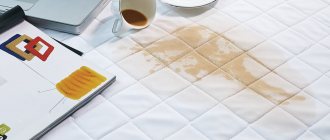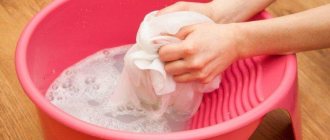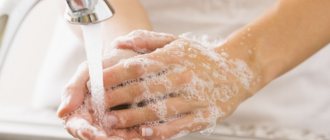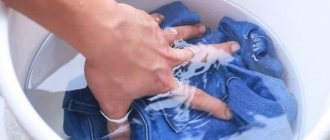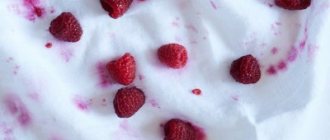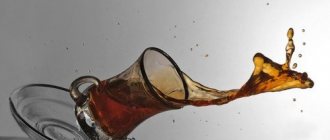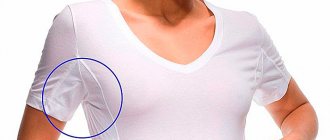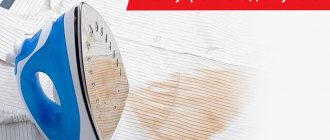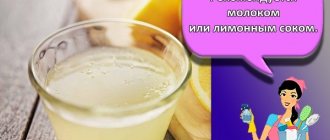Lovers of freshly squeezed juices often encounter the same problem as stains on clothes. Berry and fruit drinks are a must in children's diets, but kids get dirty with enviable regularity, and even bibs can't save you from unexpected stains.
How to wash the juice depends on what fruit it comes from. Most often you have to remove apple juice from clothes, but berry juices are considered the most corrosive. We will find out how to wash apple, cherry and other juices using both household chemicals and folk recipes.
How and with what to remove juice stains
To find out how to remove juice stains from any clothing, you need to understand the composition and properties of the fabric. For colored and undyed items, washing methods will differ. The same applies to natural and synthetic clothing. For each type of fabric there are specific folk recipes and ready-made “chemistry”.
Household chemicals
Products in the form of powders, sprays, gels, and liquid solutions are suitable for removing stains. Oxygen stain removers are preferable to chlorine stain removers. Powder stain removers have gained popularity: Sarma 5in1, Vanish Gold, Ace Oxi Magic. These products are universal and cope well with pigmented stains.
How to remove fresh juice stains on children's clothes, since ordinary household chemicals are undesirable? A special powder for washing children's clothes will return soiled clothes to a salable condition without harming the health of the baby. How do mothers remove stains from children's blouses and rompers? The list of the best means included:
- Cotico is a hypoallergenic, universal stain remover, suitable for children with sensitive skin;
- “ Eared nanny ” is a budget-friendly and effective remedy, but requires long-term exposure. If you briefly soak an item in a solution with a stain remover, the effect may not be achieved;
- “ Nanny ” is a stain remover with active oxygen and a safe composition, easy to rinse, has a neutral aroma, used separately or together with powder.
Folk remedies
If household chemicals seem too expensive, they can be replaced with folk remedies. Our grandmothers knew how to get rid of corrosive stains. Their recipes have not lost their relevance. So, you can remove juice stains using the same method as other stains: soda, laundry soap, salt.
But these products are good in the fight against newly created stains. Baking soda and salt absorb dirt well and prevent pigments from fixing in the fibers. After treatment, you can wash away the mark with laundry soap, and after 30-40 minutes the product is sent for washing.
Now let's take a closer look at how to deal with fresh and old pollution.
How to remove fresh stains
The time factor plays a decisive role in removing stains. To save your favorite blouse or sweater, emergency assistance is provided:
- Table salt. The napkin is moistened with cold water and applied to the contaminated area. Sprinkle salt on the moistened area. Salt crystals will absorb the fruit pigment from the laundry. Then wash with a stream of running cold water and use preparations for washing. Starch, talc, and soda have a similar effect.
- Cold water. The procedure is appropriate for removing tomato stains and, if possible, changing your dress. The product is turned inside out, a cloth napkin or towel is placed underneath, which is intensively soaked in liquid. Active friction of the colored piece will prevent the juice from being deeply absorbed into the fiber. The treated item is dried.
Important! To speed up drying, ironing is prohibited. Otherwise, new spots will form.
- Milk and its components, which are suitable to cope with fruit stains on delicate materials. The blouse is placed in heated milk or whey for a short time, then washed. Dairy products are also used cold, but the soaking period is extended to 1 hour. Curdled milk and kefir work well against fresh stains when used to treat the toilet for 30 minutes.
- Laundry soap. The grated product is poured with warm water in a small volume and whipped until foamy. The stained area is rubbed with a bar, then the blouse is immersed for 2 hours in the prepared soap solution.
Laundry soap
Boiling water
Freshly left stains on permanently dyed linen, viscose and cotton fabrics can be cleaned with hot water. Several techniques are used:
- The soiled item is placed in a filled basin for a couple of minutes, then washed in the usual way.
- The material is pulled out by hand and placed under a hot stream from the water supply.
- The item is placed on an empty container and secured with an elastic band. The contaminated area is watered with a boiling kettle until it disappears. Up to 4 liters of liquid will be required. The marks left on clothing determine the dimensions of the container used. Be careful when working so as not to get burned, especially before getting the material wet at the beginning of the procedure. Finish treating the steamed spot with vinegar.
Attention! Complete immersion of laundry in boiling water threatens loss of appearance.
Boiling water to fight stains
Fresh spots
You can remove stains from apple juice in the same way as from other fruits. Soap shavings and a strong soda solution can be used to wash freshly squeezed juice. If an accident occurs in a cafe, you should immediately blot the print with a paper napkin and sprinkle it with salt, and you can clean it at home.
Even cherry and currant traces can be eliminated by the following remedy: you need to mix 20 ml of alcohol with 2 g of lemon, heat to 40ᵒ C, wash the stain and leave until it discolors. Next, the item is rinsed in warm water, and if necessary, the procedure is repeated.
What is important to consider?
Under no circumstances try to wipe off fresh juice with napkins - this will only penetrate the natural dyes deeper into the fibers of the material, and it will be doubly difficult to remove stains. Spilled juice can only be gently blotted, or immediately sprinkled with plenty of salt.
Before you begin removing a stain, determine its exact origin. Are you sure the red spots were caused by cherries? Or maybe it's red wine or blood? In each case, an individual approach is required when removing contaminants.
Soap and detergents can do a poor job of removing juice stains. The fact is that they contain alkali, which only fixes the color when washed. Therefore, the first wash after berry or fruit juices should be done with cool water.
The faster you start scrubbing away the sap, the more likely you are to remove it completely from the fabric. If trouble happens in a cafe, you can sprinkle the blot with salt, hold it for a few minutes, and then shake it off - this will make it much easier to deal with the stain at home.
If stain removers are used to remove juice, their concentration should be increased gradually. It is possible that a weak solution will cope with contamination. You should not make a solution that is too concentrated, as it can corrode the paint on the fabric and ruin the item. To begin with, it is enough to dissolve half a cap of the product in a couple of liters of water. Chlorine stain removers cannot be used on colored laundry.
Old stains
An old stain is difficult to remove, be it walnut juice or a stain from a watermelon. At home, you can use ethyl alcohol, undiluted. It helps get rid of traces of sea buckthorn, strawberries, blackberries, and raspberries. The best way to neutralize pigments is hydrogen peroxide. They start with a weak solution, when it doesn’t help, mix it equally with water and even use it in its pure form if the fabric has no pattern. You can wash cranberry, sea buckthorn and peach juice from white cotton fabric by boiling it in water with hydrogen peroxide.
Dandelion and Adam's apple juices, often used in folk medicine, are highly corrosive. How to wash off maclura and dandelion juice? A weak solution of potassium permanganate helps remove traces of dandelions from clothes. After soaking the product in it, washing with powder is required.
How to wash maclura juice? This is one of the most difficult contaminants. But if you don’t delay washing, then alcohol and dimexide, used alternately, can help. It is almost impossible to wash off an old print. As a last resort, you can use turpentine or kerosene, but only on dense and natural fabrics.
Traces from tangerines, strawberries, blackberries and chokeberries are easier to remove. This mixture works well: combine 2 tsp. hydrogen peroxide, 1 tsp. dish gel and ½ bleach. Treat the stain and wash off after 25 minutes. The same remedy will help with yellow marks from aloe and sea buckthorn.
From citrus
Not all citrus fruits leave stains; moreover, some fruits even help to cope with traces of berries, take, for example, lemon juice. But old orange or tangerine stains can be corrosive.
Vinegar and baking soda will help remove stale stains from orange juice. The components are mixed equally and applied to the stain during the reaction process. Glycerin is suitable for delicate fabrics. The orange trace is treated with it and left for 2 hours.
From pomegranate or grapes
Now let's find out how to remove stains from pomegranate or grape juice. Acidic products - lemon juice, vinegar and even yogurt - can cope with dark prints. A mixture of vinegar and washing powder diluted in water helps against black grapes. For 1 liter of water take 1 tbsp. l. both components. The product is soaked in this product for an hour. This method can be used to wash red wine and grape juice.
Removing old apple stains
Removing already ingrained stains will require a little more time and effort:
- A few hours before washing, soak the clothes in water, after adding household chemicals made specifically to remove dirt. These substances can be either washing powders or special gels and fabric softeners. After soaking, wash the items.
- Acid-containing products will help you wash apples from clothes. You can use oxalic acid or concentrated lemon juice. Fill the contaminant so that the acid covers it completely. Dilute the powder with a small amount of warm water and leave to soak for 10-15 minutes, then wash.
- An unusual solution, which contains vodka and glycerin in equal proportions, will help remove old apple stains. Dampen a soft cloth with the solution and blot any traces of juice with it. After 10 minutes, the product can already be washed.
- Using ammonia diluted equally in water, you can wash off the juice that has ingrained itself into the fabric. Apply the mixture to the desired area for 5 minutes, then wash and rinse the items thoroughly.
White
How to remove apple or orange juice from white? A slice of lemon can remove marks on a white T-shirt. They wipe the stain with it and then iron it through the cotton fabric with a hot iron. If the print is not completely removed from the T-shirt, soak it in diluted bleach.
It is better to wash stains from cherry juice with an oxygen stain remover. As a last resort, use a strong vinegar solution. But much is determined by the properties of the fabric - such experiments are not carried out on a synthetic jacket or blouse.
You can wash pomegranate juice from white clothes in the same way as other types of bright juices:
- hydrogen peroxide - for natural fabrics an undiluted 3% solution is suitable, for delicate fabrics - diluted in half with water;
- vinegar - dilute 3-4 tbsp in a glass of hot water. l. 9% vinegar, treat the stain, add the remaining solution to the soaking water. This method can be used to wash both orange and carrot juice;
- ammonia - 1 tsp. ammonia take the same amount of peroxide and all components are diluted in a glass of water. The solution is used to treat the area of contamination. Wash off after depigmentation of the print. In a similar way, you can remove juice stains on both a T-shirt and a blouse.
How to wash pomegranate from clothes?
Perhaps few people can boast that they have not encountered the problem of various types of clothing contamination. In the event of such a problem, of course, you want the item to be completely cleaned and restored to its neat appearance.
Stains from fruits and berries are among the most difficult to remove. But if you accidentally stain the fabric with drops of juice, you shouldn’t give up on your item. There are a lot of folk recipes for washing clothes from a wide variety of contaminants.
This article will talk about how to remove traces of pomegranate from clothes.
Pomegranate juice and fruits are very healthy and tasty. Even the seeds are also healthy and edible. When fresh, they can be chewed along with the pulp or added to salads. Pomegranate juice has a rich, bright and deep color, it is rich in many useful vitamins and microelements.
It also contains a very large amount of acids. It is the fault of the latter that pomegranate juice eats into any fabric so much. Acids are able to penetrate deeply into the fibers and, slightly damaging the structure of the fabric, leave bright and very noticeable scarlet and red spots on clothing.
First of all, it is worth remembering that the longer the drops of pomegranate drink were on the fabric, the deeper and more firmly they penetrated into the structure of the material. It is very, very difficult to remove a neglected stain.
If you have just made a stain, blot the fabric with a paper towel or dry sponge to remove at least some of the juice from the clothing.
After this, the item should be soaked in boiling water, and the contaminated area should be washed with laundry soap. This method quickly neutralizes acidic substances, and the clothes will return to their original appearance.
When the trace of juice leaves the fabric, rinse the item and dry it as usual.
If something made of delicate material is dirty, soaking it in boiling water will not help, but will only completely ruin it. Just in case, study the product label for fabric composition and recommendations for care and washing.
If it is not possible to wash the soiled item completely, you can treat only the soiled area with boiling water. Gently pour a stream of boiling water from the kettle spout onto the fabric. If the stain cannot be removed immediately, then at least the drops of the drink will not be deeply absorbed. In the future, the clothes are likely to be completely washed with regular washing with powder.
To neutralize the acids of a fruit drink, household formulations containing alkali are helpful. For example, you can use baking soda.
Pour 2-3 liters of cool water into a basin, add two tablespoons of baking soda. Things stained with pomegranate juice are soaked in this solution for about half an hour.
Next, the clothes need to be rinsed well. This method will not harm delicate fabrics.
It is not always possible to notice a stain very quickly, especially for children's clothing, because children are not as attentive to the cleanliness of things and are not as meticulous as adults.
Stains often appear during feasts at children's parties, and the child, most likely, simply will not attach any importance to this, will not notice, or will even try to hide his mistake for a while, knowing that his mother will be unhappy.
Contamination can be detected after a few hours or even a couple of days, when the juice has already been thoroughly ingrained into the material.
In addition, when visiting or in nature, it is unlikely that you will be able to use the recommendations described above. To remove old traces of pomegranate juice, you can try some effective methods.
- The required amount of water is poured into a saucepan or metal basin. For every liter of water add 1 tablespoon of hydrogen peroxide. The solution is brought to a boil. The item should be immersed in boiling water and kept on low heat for 10 minutes. After this, remove the clothes from the boiling water and rinse them.
- An old garnet stain can be washed off well with ethyl alcohol. You need to moisten a cotton pad or toothbrush in it and rub the contaminated cloth. The operation should be repeated until the spot goes away. In addition to alcohol, any alcohol-containing uncolored liquids with a strength of 30 degrees or more are suitable.
- Silk items can be cleaned using a vinegar solution. Water and 9% apple cider vinegar are taken in a ratio of 10: 1. The solution should be applied to the stain, then rinse the item.
- You can try to remove the stain using laundry soap. Rub the contaminated area with a bar of soap and leave for 1.5–2 hours. Then wash and rinse the clothes.
- A mixture of glycerin and egg white helps fight stains from pomegranate juice. Both components must be taken in equal quantities and mixed. The composition should be applied to the fabric in the area of contamination and wait until completely absorbed. Then the item is washed in the usual way.
Many people have particular difficulties in removing stains from fruits, including pomegranates, from clothes and items made of white and very light fabrics.
A juice stain looks very bright and noticeable on such clothes and cannot be disguised in any way by coloring. However, you shouldn’t rush to throw away a good thing just because it’s contaminated by drops of juice.
There are also several simple and accessible recipes for removing stains from white fabric.
- Concentrated vinegar works well to remove juice stains from white and light-colored clothing. In addition, it acts as a gentle bleach. To 3 liters of water you need to add 3 tablespoons of 70% acetic acid. The item should be soaked in this solution for 20–30 minutes. The stain itself can be gently scrubbed with a soft toothbrush or clean sponge. After this, the clothes should be rinsed in cool water.
- If white items are dirty, you can also use a special stain remover. Such compositions are sold in household chemical departments. They can be in the form of gels, sprays, liquid chemical solutions. The product should be applied to the fabric and left for 20-30 minutes. The clothes are then machine washed or hand washed using a method suitable for the type of fabric.
- White items made from delicate fabrics can be boiled in a solution of hydrogen peroxide. Add 5 tablespoons of peroxide to 3 liters of water. The solution is brought to a boil, and clothes contaminated with traces of pomegranate are dipped into it. Boiling continues for 20–30 minutes. After this, the clothes should be rinsed in cool water.
- White clothes can be washed using bleach. It must be used according to the instructions on the package, in no case exceeding the specified dosage of the composition.
- Traces of juice on white fabric can be removed by wiping them with a solution of ammonia. A cotton pad or sponge should be moistened in water to which an equal part of ammonia has been added (1:1 solution). Using the dampened material, gently blot and lightly rub the pomegranate stain. Wash your clothes afterwards.
It is important to know the following.
- Don't put off washing soiled items.
- Take the time to try several cleaning methods suitable for the fabric. In many cases, you can get rid of a stain using a combination of two or three products.
- If you doubt your abilities and are afraid of ruining something dear to you, it is better to contact a professional dry cleaner.
- If the trace of juice has not been completely removed, but you still want to wear the item, use your imagination: you can place a patch, applique on the stained area, embroider a pattern on it, or decorate it with a rhinestone ornament.
- In extreme cases, you can try radical methods of stain removal. These include the use of purified gasoline, acetone or white spirit. Wipe the contaminated fabric with the mixture. After this, be sure to wash the item, preferably in a washing machine with an additional rinse cycle.
- Before using an aggressive solution, such as bleach or acetone, test its effect on a small, hidden area of the item. For example, apply a small amount to the inner seam. Observe the results. If there are no negative consequences for the fabric, you can use a composition to remove contamination.
To learn how to remove a pomegranate stain, watch the video below.
Cotton and linen
Removing traces of berries from clothes made from natural fabrics is a little easier. Products can be boiled, bleached if they have no pattern, and washed with chlorine-containing products. Cotton is not afraid of high temperatures, and it is hot water that best copes with traces of berry and fruit juices.
To make a T-shirt or shirt sparkle white, just soak the item in bleach diluted in water according to the instructions. Among home remedies, vinegar, vodka or alcohol, and a 3% hydrogen peroxide solution have proven themselves to be effective.
Cleanliness and freshness are easy
Parents want to see their children not only neat and neatly dressed, but also cheerful, active and sociable.
Excessive comments sometimes help solve the first problem, but at the same time negate such important qualities of the child as sociability and cheerfulness, openness to new and interesting things.
Knowing how to deal with troubles - dirt and numerous damages caused to children's clothing - will allow you not to spoil your child's mood for no reason, but to simply and quickly deal with the problem that has arisen.
Carpets and rugs
It will be possible to remove traces from the carpet if the contamination is detected in time. First, juice stains are blotted with a dry cloth so that they do not spread over the entire surface. Then prepare a solution for carpets from shampoo and water, following the instructions suggested by the manufacturer. If juice stains are difficult to remove, prepare a mixture of glycerin and vodka. The components are mixed equally, a cotton swab is moistened in the solution and passed over the stain, and washed off after 10 minutes.
Another interesting way to clean carpets is using carbonated mineral water. It prevents pigments from becoming embedded in the fibers. But the method is good for early detection of the stain.
After the procedure, it is important to dry the carpet properly. It is recommended to place a towel on the wet area and press it down with a heavy one. Once the moisture is absorbed, the towel is replaced. By analogy, paper napkins are used.
Anti-stain products
It is advisable to treat the contaminated area from the wrong side. In addition, a multi-layer paper towel or a white napkin is placed under the material, which is folded a couple of times.
This way the contamination will not spread further along the shirt. When working with stain remover, use a white cloth or cotton swab. The use of chemicals provokes shedding and worsens the problem.
In addition to cotton swabs, ammonia and peroxide, the following will help in resisting pollution:
- vodka;
- steep pitch;
- acid or lemon;
- egg yolk;
- salt;
- glycerol;
- table vinegar;
- stain removers.
ARTICLE FOR YOU
How and with what to remove foundation stains from clothes and linen
Salt
Cushioned furniture
Removing juice stains from a sofa is more difficult due to the texture of the upholstery. Velor and jacquard are cleaned only using the dry method. Dry cleaning will remove juice stains from microfiber and flock. As an alternative, you can use soda, laundry soap and salt diluted with water to a paste. But these products only deal with fresh stains.
Dear readers of the Tkan.Club website, if you still have questions on this topic, we will be happy to answer them. Leave your reviews, comments, share stories if you have dealt with vegetable oil stains! Your life experience may be useful to other readers.
Rules for choosing bleaches
In order to thoroughly wash a child’s white clothes and return them to their original color, the use of bleaches is allowed. Just not the traditional ones containing chlorine, but special ones - for children, based on peroxide.
Here is a list of the best products from this series that will help remove even stubborn stains:
- Eared Nian;
- Umka;
- Big Wash;
- Nanny;
- Tobi Kids.
For old stains, use a stain remover.
Universal products on sale: table
| Name/price | Peculiarities | Flaws |
| BOS Oxi (Bos Oxy)/70 rub. | The liquid is better washed out of the fabric fibers when rinsing. Copes with the task at any water temperature. Does not contain chlorine. Has a whitening effect. | Removes only fresh stains. |
| BOS Plus powder/45 rub. | Allows you to save detergent, enhancing its effect. Whitens items without destroying the fiber structure. Copes equally effectively with fresh and old stains. Disinfects laundry. Preserves the color of the material. Product based on active oxygen, does not contain chlorine. | Fast consumption, but it is compensated by low cost. |
| Vanish Oxi Action (Vanish Oxi Action)/140 rub. | Safe for all types of fabric. Suitable for linen of any color. Use locally, for soaking and general washing. | Does not cope with old stains. |
| Home Amway (Home Amway) stain remover/700 rub. | Easy to apply - available in spray form. Eliminates any, even the most difficult stains. Nice smell. It works quickly. | High price. |
Important: Be sure to read the packaging before use. Otherwise, there is a high probability that the use of the chemical will harm the material.
Remove stubborn stains from purees, juices and food
Sometimes it seems to young parents that it is easier to buy new things for the child than to remove yellow stains from mashed potatoes or feces on old clothes. However, the following “grandmother’s” advice can prove the fallacy of this opinion.
9% table vinegar
Dilute a few tablespoons of vinegar in 1 liter of hot water and soak baby clothes in it. Wait at least 1 hour, then wash the items in the machine.
Information. As reviews show, most mothers use vinegar to quickly remove stubborn stains on children's clothes.
Laundry soap and boiling
Sometimes, in order to remove long-standing urine stains on panties, you should resort to such an old method as boiling. Laundry soap will help make the method more effective:
- And to do this, finely chop ¼ of a bar of soap with a knife and add it to the water that is on the fire;
- As soon as the liquid boils, put all children's things stained with yellow or other stains into a basin or bucket;
- Using wooden tongs or a spatula, continually immerse the items in the water to make the boiling process more efficient;
- Treat the stains with this product for at least 1 hour, then wash the items in the machine.
Vinegar and soda
You can also remove stubborn stains of various origins using baking soda, which is applied to the stains after vinegar.
- But first, table vinegar should be diluted with water in a ratio of 1:3.
- Soak all the stains in the resulting solution and immediately, without waiting for them to dry, sprinkle them with soda.
- Wait at least 1 hour and then wash the items.
What to do if nothing helps
Chocolate, beloved by children, causes many problems for mothers who want to see their kids neat and beautifully dressed.
The modern chemical industry offers a huge range of household chemicals. But not everyone trusts such compounds: they cause allergies and sometimes do not give the expected effect.
Before you begin, you need to determine the type of fabric and the origin of the stain:
- Stains from red wine, fresh berries and juices can be cleaned using a mixture of egg yolk and glycerin. The mixture should be applied to the problem area, left for one and a half to two hours and washed with laundry soap.
- You can remove stains from light-colored items made from delicate fabrics with a mixture of 10 parts white laundry soap, 2 parts turpentine and 1 part ammonia. First, the product needs to be soaked with detergent for several hours, and then the problem areas should be generously moistened with the prepared mixture and washed in a machine.
- Blood or chocolate stains can be smeared with a paste of potato starch and water. The applied mixture should dry, and then it should be washed off with warm water and soap.
Adviсe
If there is no time to remove fresh berry stains from clothing, the stained area should be rinsed under running cold water. This way, part of the natural pigment is washed out of the fabric, which greatly simplifies the delayed process of removing traces of berries.
Do not wash away traces of berry juice with laundry soap . Interacting with alkali, the pigment changes shade and is absorbed even more firmly into the fabric fibers.
Soaking for two hours in whey will simplify the process of removing berry stains from fabric. To prevent the berry trail from spreading during the cleaning process, it must be covered around the edges with a layer of starch or crushed chalk.
Under no circumstances should berry marks be rubbed, only gently blotted. Treatment with cleaning compounds occurs in a circular motion , from the edge to the center of the contamination. This way the stain will not spread across the surface.
When treating stains with any cleaning agent, place a white cloth under the stained area. This will help prevent colored stains from transferring onto the clean side of the garment.
